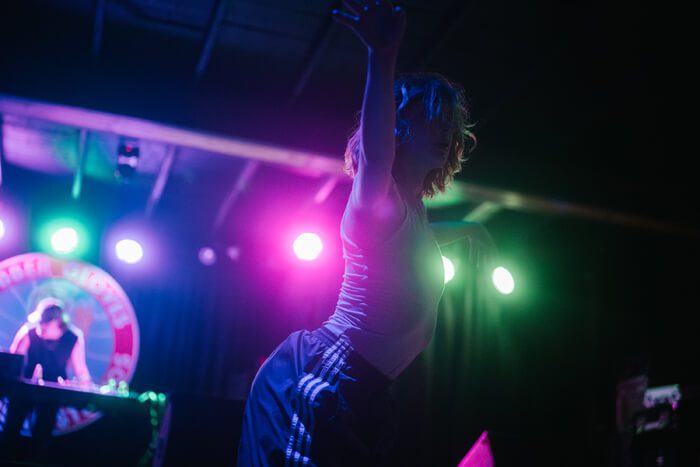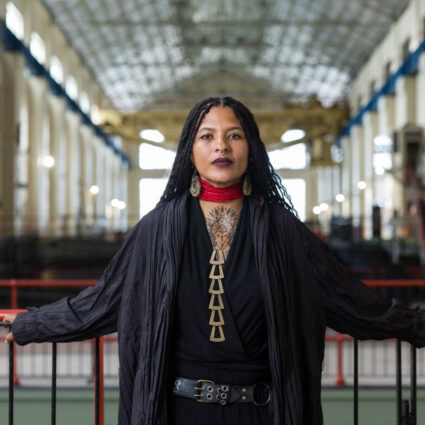Emerging choreographer Alexandra Honchell’s journey from company dancer to independent artist is reuniting her mind with her body.
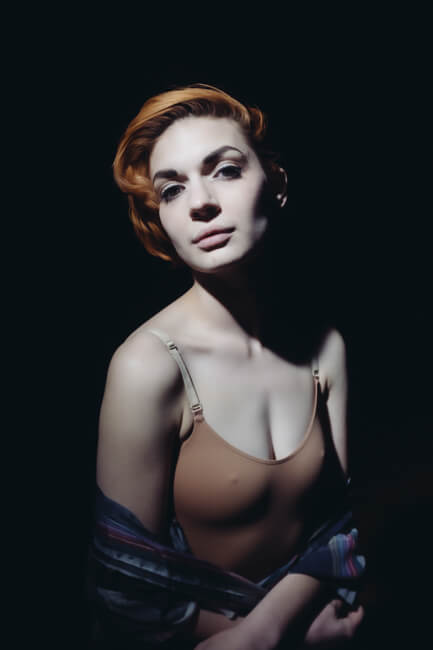
Alexandra Honchell begins to pace onstage as her body channels the unfolding scene. Another dancer and two musicians whose names were drawn with hers are playing cold as a group for twenty minutes.
Her hands twist the slack of her oversized t-shirt, tug her knee to her chest, reach above her head as her legs strike attitude derrière. She melts into a slouch. Each shape folds and shifts, a heated conversation turning inside out.
Aaron Gonzalez’s hands flicker over the board of a double bass. Honchell observes him like a scientist, then takes over as a puppeteer, waving her fingers to pantomime energy theft. Gonzalez collapses playfully over the instrument as if depleted.
Honchell reveals the sweeping drama of what is already here: the musician is also a dancer, and an internal violence, a constant shedding of skin, is required to move through the world.
•
A day before this August 23, 2021 improv lottery at Rubber Gloves Rehearsal Studios in Denton, Honchell returned from a weeklong workshop in Ann Arbor, Michigan hosted by the New York City-based Vim Vigor Dance Company. She danced with other trained dancers there—an exercise notable for Honchell not just because of limits imposed by the pandemic.
She has been working as a solo body for the past two years after traumatic experiences dancing with a contemporary ballet company in Dallas left her spiritually and physically exhausted. Honchell’s recent process documentation on Instagram shows an open and visceral investigation of technique’s relationship to destruction.
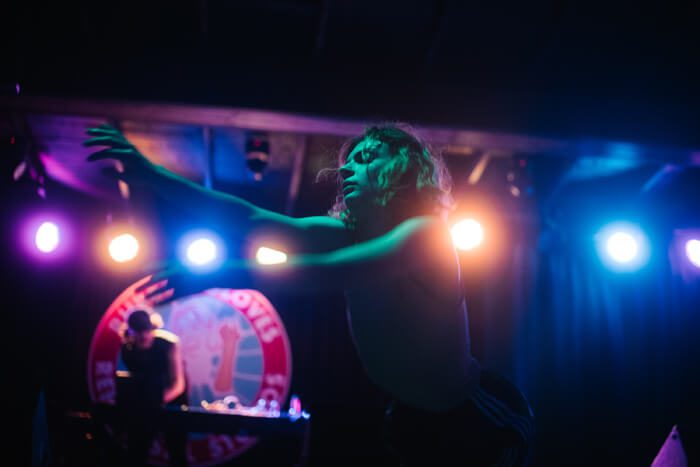
The dimensional quality of Honchell’s movement approaches that of Juliano Nunes, who has trained the performer FKA twigs and choreographs haunting ballets for international companies. Honchell has been a first entry to the possibilities of movement for many of her collaborators who work in other media.
“When I say ‘dance’ it seems like an oversimplification—I don’t feel like that does it justice,” says Judd Myers, a Dallas-based film director who Honchell counts among her closest collaborators. “It transcends words and the intellect and all of these things that tend to clutter things up… I make films because I’m terrible at talking and communicating—that’s why [what Honchell does] resonates with me so much. It cuts straight through and hits you from the inside.”
Honchell was accepted to Art Factory International in Bologna, Italy this fall to train for eight months as an independent dance artist. This new chapter means everything for her hopes to grow as a choreographer.
“My least favorite question I get asked is, ‘Oh, what is your art about, like, what is your work about?’ Because I don’t want to sit there and be like, ‘Oh, it’s about trauma…’” Honchell says.
“All those things are part of me and they’re still here, like they’re still in my body. Those patterns that I developed during that time in my life are literally, like, still in my body. So it’s like, yes, that is part of what my work is about. But the other part of it is the journey out of that: trying to rediscover dance, and what that is to me, because it was so lost for me for a long time.”
•
“Discovering that you are not wrong or less than, but that you are just different, is a joy,” says Deborah Weaver, once a choreographic assistant to the legendary Alvin Ailey.
Weaver was teaching class at Ballet Conservatory in Flower Mound, Texas when she crossed paths with Honchell, a serious, raven-haired sixteen-year-old who had been committed to a career in ballet for almost half of her life.
“Divine geometry,” Weaver explains, is the central quality of ballet that keeps dancers bonded to the art form and to the comforting repetition of barre. Honchell had beautiful lines. But Weaver knew she was looking at a singular young artist. Time showed her she was right. Honchell can choreograph like the Hindu goddess Kali, she says, a nurturing commander of time and the dualities of violence who is often shown holding a decapitated head.
Honchell graduated early from Marcus High School in Flower Mound in 2015 to dance as an apprentice with what was known then as Bruce Wood Dance Project. It was a pivotal moment in the Dallas-based, nationally renowned company’s history. The founder who gave the group its name died unexpectedly the year prior. Kimi Nakaidoh took over as artistic director. She’d been a dancer for the company; like Honchell, she’d veered from classical ballet to the contemporary realm, which is generally known for inclusivity and encouraging a broader range of expressive movement.
Nakaidoh remembers Honchell as “a lovely dancer with beautiful movement quality and musicality.” Honchell saw the objectively significant achievement of joining Bruce Wood as a kind of consolation that paled to dancing with a traditional ballet company; she relied on Kind snack bars and famously difficult Dallas Area Rapid Transit—she didn’t have a car—through ten-hour dance days shared between her childhood studio in Flower Mound and Bruce Wood. Any moments of pause with much older dancers in Dallas could feel isolating for the painfully shy eighteen-year-old.
“I never brought any food with me. I would just kind of sit and listen to other people talk at lunch. I just didn’t really know how to try to interact with anyone else. It was pretty lonely,” she says.
One of Honchell’s extreme gifts: she can suggest complete derangement while still appearing in total command of her flow and articulation.
Apprentices were not expected to perform with Bruce Wood Dance Project as part of their contract. But Honchell was chosen to dance a duet with Albert Drake in a restaging of Wood’s Polyester Dreams, an ode to music of the 1970s by the likes of Gladys Knight and Marvin Gaye. She rehearsed and performed with the company, but says she was not paid an hourly rate like the other dancers who performed.
Nakaidoh declined to comment on the record about Honchell’s compensation, instead offering this statement: “The goals and compensation for apprenticeships vary between companies, as well as for the same company over time. When Ali worked with Bruce Wood Dance, we appreciated the gift of her talent in our studios and on stage and also hoped to provide her with the valuable experience of working amongst older, more seasoned colleagues.”
Numerous suggestions from Bruce Wood leadership led Honchell to believe she would return after the summer to dance officially with the company, she says. Honchell turned down schools to which she was accepted, like Fordham University, a partner program to the Ailey School. Honchell was at a workshop in New York when she received an email notice that her contract would not be renewed.
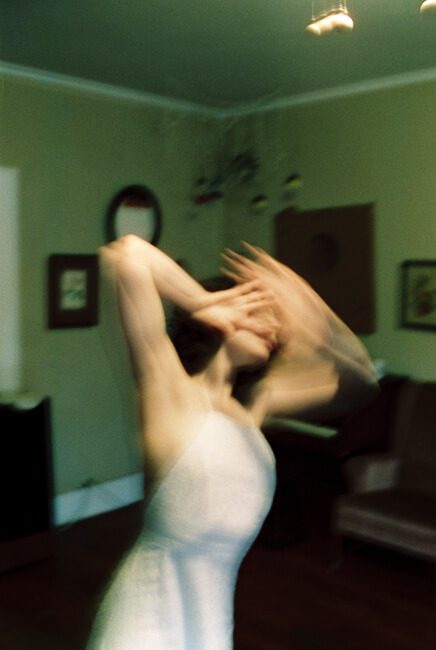
“I got home and I didn’t have anything to do. And that’s when everything just sort of crumbled and fell apart for me because I didn’t have this, like, structure in my life. All of a sudden everything was gone and I didn’t have anything to hold on to anymore,” Honchell says.
“And my home life was not great … there was this looming feeling of: what the fuck are you going to do now? Why aren’t you doing anything? There’s this expectation that I was just suddenly supposed to move on to the next thing or move on from dancing and go to school. To stop dancing—I couldn’t process that. That was my entire life. I just lost, like, my entire life. I didn’t know what to do.”
A photographer who worked on contract with Bruce Wood had taken an interest in Honchell when she was still an apprentice with the company who would otherwise have been in high school, had she not graduated early. He’d sent her messages on Facebook admiring her guttural, Basquiat-esque visual art and sharing links to songs. They entered a relationship; Honchell says she endured emotional abuse from him while he continued to move in circles adjacent to Bruce Wood and photograph dancers in the company. He was in his early fifties, and Honchell was nineteen.
Southwest Contemporary attempted to reach the photographer, who we’re choosing to keep unnamed. After initially agreeing to an interview, the photographer didn’t respond to multiple requests for comment.
Honchell found solace in teaching before leaving him a year later. She eventually enrolled in community college, made the dean’s list, and found some friends in Denton where her brother lived, a college town forty-five minutes from Dallas with its own creative ecosystem and an experimental music scene that mirrored her sensibilities as an artist.
•
Ruby Arthur would’ve described the Ali she met (Capricorn sun, Aries moon, Cancer rising) as a “brilliant, trained dancer, practicing all the time with two jobs, and is also a beautiful visual artist… with an extremely recognizable voice.” Honchell heard some blown-out no wave recordings Arthur made on Voice Memo and initiated a collaboration at Brickhaus in Denton, which was the kind of place where anti-folk artist Kimya Dawson would stop on tour and draw whatever you wanted on t-shirts with a sharpie.
“I had only played twice in public really at that point, only solo performances, and this first thing with Ali ended up being my first set with a band, which I threw together asking anybody who would,” Arthur says. “Ali was fantastic and, like, revelatory that night.”
“Similarly to music, there’s a moment when you realize every kind of structure operates harmoniously according to its own logic, and Ali was a big part of my discovery of that idea in application to conscious movement of the body in general,” says Arthur.
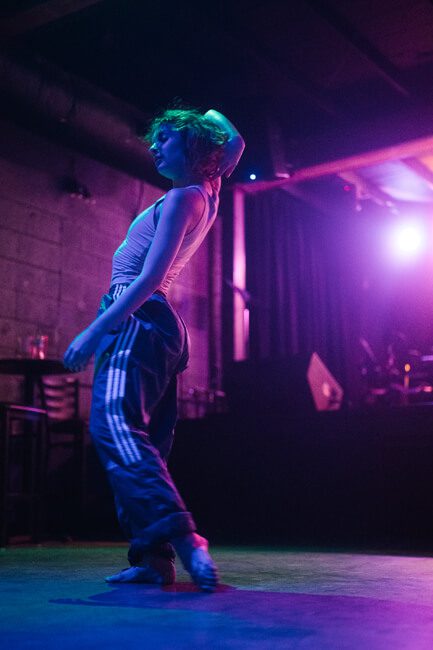
Contact improv heavily influenced a mode of dancemaking brought to TWU by dance professor Sarah Gamblin. She danced for seven years in New York City with Bebe Miller, a choreographer whose process includes the dancers in her company. There is a kind of building Gamblin recognizes in Honchell’s ten-minute-long, uncut improv sequences.
“What I connect to, what I see, is this evolution of a process. An artist in a process—the artist becoming over time, the kind of courage it takes to say, ‘Here’s what I am, here’s what stands for dance.’ It takes a lot of courage to put out movements that are not like these like pointy feet and strong legs that are super phallic and ‘powerful’ and weaponized,” Gamblin says.
“I mean, she’s using [formally trained gestures], but she’s also not relying on that. She’s learning how to use it, not just say, ‘Here’s what justifies my existence.’”
•
The studio where Honchell has been dancing at Arts Mission Oak Cliff has an abundance of natural light. It’s a steady character in the videos she makes here. So is the floor—a partner for the solo dancer in contact improvisation, a foe she hopes to master.
The first twenty minutes each day in the studio are quiet. In place of traditional warmups or barre progressions, Honchell eases into the day by listening to her body and acknowledging what is going on in her mind, even if that simply means honoring frustration. Language sometimes becomes an anchor to her mind.
“I felt frustrated with the process. I didn’t feel comfortable working by myself yet, so I came up with different ways to engage myself. When I felt like I was hitting a wall, certain words would pop into my head and I would write them in my journal,” Honchell explains, opening a notebook to show me what she means. “I’m so tired” is scrawled playfully down one page like a meditation.
“Dysmorphia” is a word that comes up for Honchell when trying to assign language to what she’s hashing out in her daily sessions. The demands ballet and diagnosed PTSD have put on her body, the impossibility of the shapes—these are the tools and the subjects of her work. She’s reorganizing the data in her cells of all that training into something astonishing.
At times her movements look like a self-aware play of performance and retreat. As a stylist, Honchell conjures polyphony like a free-jazz drummer, with dynamics so rich that beats assume tonal shades.
One of Honchell’s extreme gifts: she can suggest complete derangement while still appearing in total command of her flow and articulation. Another: she enables others to fully inhabit their own bodies in the moment, whether they are dancing with her or watching her dance.
“You live here, like, this is your home—you have to take care of it, you know, so you don’t fall apart,” Honchell says.
“Another word that I think about a lot is ‘accessibility.’ I feel like I’m trying to make my body more accessible to me. Because I feel like for so long, I was making it accessible to other people… and now I’m at a point where I don’t want that anymore. Like, I can’t live like that anymore. It’s not good enough for me. So the transition from that is: I’m using my body and my brain to create my own vision.”
